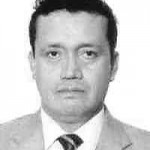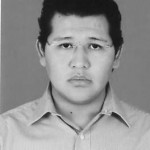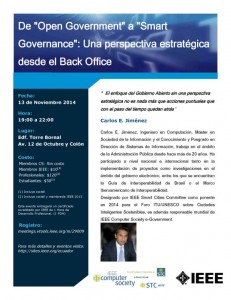Comparison of Techniques Used in the Acquisition Process of ECG Signals
5 de Noviembre , 2015. 9:00 GMT-5
Flavio Pineda , MSc, PhD(c)
The course is aimed to the design of acquisition systems of ECG signals, by means of the use of hardware and software architectures, for signal processing. Virtual Instrumentation Tools, such as LabVIEW, will be presented for the storage and display of the acquired signal. Under this scope, the ECG signal processing by embedded cards will be assessed with respect to its processing on the virtual instrumentation tool, and also with respect to its processing in hardware by using active filters. The focus of this webinar is to highlight the advantages and disadvantages of these three methods on the ECG signal processing, in order to determine their performance in real applications. Each method will be presented with real data results for its analysis.
Acerca del Expositor
 Flavio Minos Pineda López holds a Master of Science in Telecommunications Networks applied to Telemedicine from Universidad Rey Juan Carlos of Madrid, Spain. He works as a teacher-researcher in the Biomedical Field of the Electrical and Electronic Department at the Universidad Politécnica de las Fuerzas Armadas – ESPE since 1994. He has been developing his PhD research in the Biomedical Field at the Universidad Rey Juan Carlos. He is a PhD candidate since 2013. His research is focused in ECG compression signal with mobile devices for clinical applications.
Flavio Minos Pineda López holds a Master of Science in Telecommunications Networks applied to Telemedicine from Universidad Rey Juan Carlos of Madrid, Spain. He works as a teacher-researcher in the Biomedical Field of the Electrical and Electronic Department at the Universidad Politécnica de las Fuerzas Armadas – ESPE since 1994. He has been developing his PhD research in the Biomedical Field at the Universidad Rey Juan Carlos. He is a PhD candidate since 2013. His research is focused in ECG compression signal with mobile devices for clinical applications.
ROS Technology Applied to Bionic-Intelligent Prosthesis
12 de Noviembre, 2015. 9:00 GMT-5
Andrés Erazo Sosa, MSc
ROS is an operative system used in the creation of applications for robots. In particular, its incorporation in the Biomedical area could be directed to the automation of robotic prosthesis. This webinar focus on the idea to incorporate ROS programming to prosthesis software in order to acknowledge an efficient operation of the prosthesis, and leading even to a trustful performance of the process and safe behavioral results for the user. Also, due to its methods of processing information by means of specialized blocks and by its real time characteristics, it allows a stratification of the information according to different stages of its processing; being that information: EMG signals, EEG signals, or any other type of data. Each acquisition method generates different parameters of measure, but ROS could work on them to produce specific data in order to operate the prosthesis. In the same way, ROS is not tied to the mechanical issues of the device to be incorporated to the user, just coupling block are needed to accomplish normal operation of different type of prosthesis. These and other characteristics of ROS would be analyzed in order to determine its applicability in Intelligent Prosthesis Automation.
Acerca del Expositor
 Andrés Erazo holds a Master of Engineering Science in the Electronic Field, with a specialization in Biomedical Science and Robotics, from the University of Queensland (Australia). He works as a professor-researcher in the Electrical and Electronic Department at the Universidad Politécnica de las Fuerzas Armadas – ESPE. His research is focused in Prosthetics and Cyborg Technologies and his scientific interests include also educational approaches, bio-electronic science, bio-inspired robotics and micro/nano-electronics.
Andrés Erazo holds a Master of Engineering Science in the Electronic Field, with a specialization in Biomedical Science and Robotics, from the University of Queensland (Australia). He works as a professor-researcher in the Electrical and Electronic Department at the Universidad Politécnica de las Fuerzas Armadas – ESPE. His research is focused in Prosthetics and Cyborg Technologies and his scientific interests include also educational approaches, bio-electronic science, bio-inspired robotics and micro/nano-electronics.
Methods to Discriminate Classes In Multivariate Models and its Application in Electronic Noses
19 de Noviembre, 2015. 9:00 GMT-5
Ana Verónica Guamán Novillo, MSc, PhD(c)
This webinar tackles an open issue about how to determine if a model discriminate different categorical groups. In medicine, p-value is the typical figure of merit for concluding that a variable or feature is statistically significant. However, many times this approach is not enough or even worse it is overoptimistic. The use of multivariate models can be a good option to determine if a set of features provide robust model for discrimination purposes. The focus of this webinar is to demonstrate that sometimes the use of statistical p-value do not provide discriminative information. In addition, we are going to explore this phenomenon in electronic noses (e-noses). Electronic noses seek mimicking olfactory system and have several applications; one of them is on the medical field.
Acerca del Expositor
 Ana V. Guaman gets her degree in Electronic Engineering in 2006 and in 2010 she got her Master in Biomedical Engineering at Universidad de Barcelona (España). From 2008 to 2014 she worked as researcher in signal and information processing for Sensing Systems Group at Institute for Bioengineering of Catalonia. She started her PhD studies in 2010 at Universidad de Barcelona in the doctoral program of engineering and advanced technologies, which is expected to be finished in 2015. Her PhD thesis is entitled «Multivariate Signal Processing for Quantitative and Qualitative Analysis of Ion Mobility Spectrometry Data, Applied to Biomedical Applications and Food Related Applications». Since 2014, she is working at Universidad Politécnica de las Fuerzas Armadas – ESPE where she is performing as researcher on the electronic noses project.
Ana V. Guaman gets her degree in Electronic Engineering in 2006 and in 2010 she got her Master in Biomedical Engineering at Universidad de Barcelona (España). From 2008 to 2014 she worked as researcher in signal and information processing for Sensing Systems Group at Institute for Bioengineering of Catalonia. She started her PhD studies in 2010 at Universidad de Barcelona in the doctoral program of engineering and advanced technologies, which is expected to be finished in 2015. Her PhD thesis is entitled «Multivariate Signal Processing for Quantitative and Qualitative Analysis of Ion Mobility Spectrometry Data, Applied to Biomedical Applications and Food Related Applications». Since 2014, she is working at Universidad Politécnica de las Fuerzas Armadas – ESPE where she is performing as researcher on the electronic noses project.
Analysis of Cardiorespiratory Interaction in Patients with Cardiac and Respiratory pathologies
26 de Noviembre, 2015. 9:00 GMT-5
Andres Arcentales V., MSc
Respiratory sinus arrhythmia is an index of cardiac vagal excitation, which can be considered to be a phenomenon that results directly from the interaction between the cardiovascular and respiratory systems. It is well known that cardiac and respiratory systems are connected and controlled by the autonomous nervous system; therefore, changes in the cardiac behavior produce changes in the respiratory system, and vice versa. This webinar is focused on the fact that the study of the cardiorespiratory interaction could improve the classification and stratification of patients with cardiac and respiratory pathologies. Also, we propose a method of analysis where patients undergoing weaning trials could be characterized and classified. This analysis of the cardiorespiratory interaction is performed through the spectral analysis and is based on the Magnitude Squared Coherence (MSC) Method.
Acerca del Expositor
 Andrés Arcentales obtained the degree in Electronic Engineering from the Escuela Politécnica de las Fuerzas Armadas – ESPE at 2006. From the Universidad de Barcelona obtained his Master’s Degree in Biomedical Engineering at 2010. Since 2010 has been candidate for a Ph.D. in Biomedical Engineering at the Universidad Politécnica de Cataluña. During his Ph.D. studies he worked on signal processing and interpretation, specialized in cardiovascular and respiratory signals. Since 2014 he works at the Electrical and Electronic department at the Universidad Politécnica de las Fuerzas Armadas – ESPE.
Andrés Arcentales obtained the degree in Electronic Engineering from the Escuela Politécnica de las Fuerzas Armadas – ESPE at 2006. From the Universidad de Barcelona obtained his Master’s Degree in Biomedical Engineering at 2010. Since 2010 has been candidate for a Ph.D. in Biomedical Engineering at the Universidad Politécnica de Cataluña. During his Ph.D. studies he worked on signal processing and interpretation, specialized in cardiovascular and respiratory signals. Since 2014 he works at the Electrical and Electronic department at the Universidad Politécnica de las Fuerzas Armadas – ESPE.
Certificados
Los webinars no tienen costo; sin embargo si se desea certificados de desarrollo profesional (PDH) emitidos por IEEE los costos que rigen son:
Miembros IEEE – EMBS: USD $5,00
Miembros IEEE: USD $10,00
Otros: USD $20,00
Escribir a eventosecuador@ieee.org para acceder al programa de certificados.

